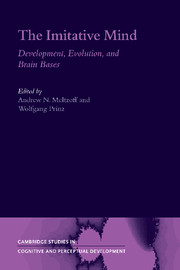Book contents
- Frontmatter
- Contents
- Contributors
- Acknowledgments
- An introduction to the imitative mind and brain
- Part I Developmental and evolutionary approaches to imitation
- Part II Cognitive approaches to imitation, body scheme, and perception-action coding
- 8 Experimental approaches to imitation
- 9 Imitation: Common mechanisms in the observation and execution of finger and mouth movements
- 10 Goal-directed imitation
- 11 Visuomotor couplings in object-oriented and imitative actions
- 12 On bodies and events
- 13 What is the body schema?
- Part III Neuroscience underpinnings of imitation and apraxia
- Index
12 - On bodies and events
Published online by Cambridge University Press: 22 September 2009
- Frontmatter
- Contents
- Contributors
- Acknowledgments
- An introduction to the imitative mind and brain
- Part I Developmental and evolutionary approaches to imitation
- Part II Cognitive approaches to imitation, body scheme, and perception-action coding
- 8 Experimental approaches to imitation
- 9 Imitation: Common mechanisms in the observation and execution of finger and mouth movements
- 10 Goal-directed imitation
- 11 Visuomotor couplings in object-oriented and imitative actions
- 12 On bodies and events
- 13 What is the body schema?
- Part III Neuroscience underpinnings of imitation and apraxia
- Index
Summary
A category is a category is a category. The whole point of categorization is to treat unlike things as if they were alike. After all, if we treated each encounter with each object or event as the unique thing it is, we would be unable to generalize, unable to learn, unable to remember, unable to communicate. Ignoring differences underlies all of cognition. But which differences to ignore? And are all categories alike, or do some, in particular those associated with our bodies and their actions, have a special status? First, we review the structure of categories, then the special features of bodies and events, and finally relate them together and to the topic of this book, imitation.
Structure of categories
Defining features or family resemblance?
What has been termed the “classical theory” has been trounced in recent decades as a theory of how people decide on category membership or draw inferences about category members (e.g., Medin, 1989; Miller & Johnson-Laird, 1976; Rosch, 1978; Smith & Medin, 1981). At the core of the classical view is the notion of defining features, features that are singly necessary and jointly sufficient for category membership. Certainly some legal and mathematical categories, such as citizenship and odd number, have that character. But psychologists want to know how people think about categories: do they think of categories in terms of necessary and sufficient conditions? The evidence suggests otherwise. It suggests that people think of categories in terms of central tendencies or frequent features or typical examples.
- Type
- Chapter
- Information
- The Imitative MindDevelopment, Evolution and Brain Bases, pp. 221 - 232Publisher: Cambridge University PressPrint publication year: 2002
- 9
- Cited by

